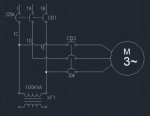So, I have a 225A breaker. Connected to the bottom of this breaker, I have a cable going to a transformer rated for 100KVA and another cable going to a 30A breaker. According to Table 310.15(B)(17) in the NEC, the conductors of these two cables must be 1/0 AWG (assuming 90deg, THHN, single-insulated conductors). Is it ever okay, under any circumstance or using a different code that can be considered to become UL approved, to use a smaller conductor than 1/0 AWG going into the 30A breaker? If so, can the conductors of this cable be allowed to be sized as small as 14 AWG?
You are using an out of date browser. It may not display this or other websites correctly.
You should upgrade or use an alternative browser.
You should upgrade or use an alternative browser.
Branch Circuit Conductor Size
- Thread starter bbarnett
- Start date
- Status
- Not open for further replies.
- Location
- Massachusetts
Well forget 90c because the terminations will be 75 c
That means you would need 4/0 copper for 225 amps.
But much more info is needed, these might be tap conductors which could change things.
That means you would need 4/0 copper for 225 amps.
But much more info is needed, these might be tap conductors which could change things.
iwire,
Thanks for the help. Sorry, it was not correct for me to say 'cable'. They are all single-insulated conductors downstream of the 225A breaker.
So,
Thanks for the help. Sorry, it was not correct for me to say 'cable'. They are all single-insulated conductors downstream of the 225A breaker.
So,
- Assuming the feeder tap length is 4m and satisfies the other requirements of 240.21(B)(2), then taking 1/3 of the 225A breaker is 75A. Therefore, the conductors must be at least 6 AWG, correct?
- Assuming the feeder tap length is 3m or less and satisfies the other requirements of 240.21(B)(1), then it is acceptable to have 14 AWG conductors supply the 30A breaker, correct?
- Location
- New Jersey
- Occupation
- Journeyman Electrician
iwire,
Thanks for the help. Sorry, it was not correct for me to say 'cable'. They are all single-insulated conductors downstream of the 225A breaker.
So,
- Assuming the feeder tap length is 4m and satisfies the other requirements of 240.21(B)(2), then taking 1/3 of the 225A breaker is 75A. Therefore, the conductors must be at least 6 AWG, correct?
- Assuming the feeder tap length is 3m or less and satisfies the other requirements of 240.21(B)(1), then it is acceptable to have 14 AWG conductors supply the 30A breaker, correct?
No and no. You would need a #4 AWG for the first scenario because the conductor needs to be at least 75 amps. In the second scenario you need a conductor with an ampacity of 22.5 amps and if you terminate that on a 30 amp OCPD then it needs to be a #10.
- Location
- Illinois
- Occupation
- retired electrician
I don't see how 240.21(B)(2) applies to conductors between a breaker and a transformer.
Maybe I'm missing something...
Why would I use Table 310.15(B)(16) over Table 310.15(B)(17)? Is it because the terminations are the limiting factor? Do they not design terminations that Table 310.15(B)(17) could apply to?
Could the circuit below ever be considered a feeder tap?

Why would I use Table 310.15(B)(16) over Table 310.15(B)(17)? Is it because the terminations are the limiting factor? Do they not design terminations that Table 310.15(B)(17) could apply to?
I don't see how 240.21(B)(2) applies to conductors between a breaker and a transformer.
Could the circuit below ever be considered a feeder tap?

- Location
- Massachusetts
Do they not design terminations that Table 310.15(B)(17) could apply to?
When dealing with equipment like panelboards, circuit breakers, contactors, switches etc. under 600 volts none of the equipment is rated over 75 C and that limits us to the conductor ampacity at 75 C. See 110.14.
There are ways around that but usually you are better off not trying to work around it, just use bigger conductors.
- Location
- Massachusetts
Yes.
- Location
- Illinois
- Occupation
- retired electrician
Maybe I'm missing something...
Why would I use Table 310.15(B)(16) over Table 310.15(B)(17)? Is it because the terminations are the limiting factor? Do they not design terminations that Table 310.15(B)(17) could apply to?
Could the circuit below ever be considered a feeder tap?
View attachment 15302
Yes, the conductors to the motor are feeder tap conductors. The conductors from the breaker to the transformer are feeder conductors and must have an ampacity of 225 amps or more.
- Location
- Illinois
- Occupation
- retired electrician
What wiring method are you using? 310.15(B)(17) is for conductors in free air. That would be a very uncommon wiring method to feed a transformer or a motor.Maybe I'm missing something...
Why would I use Table 310.15(B)(16) over Table 310.15(B)(17)? Is it because the terminations are the limiting factor? Do they not design terminations that Table 310.15(B)(17) could apply to?
- Status
- Not open for further replies.


